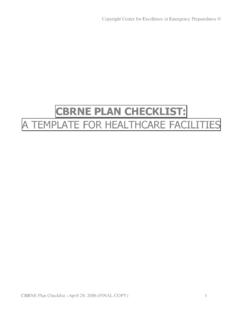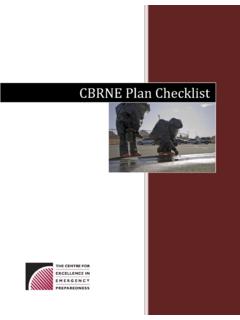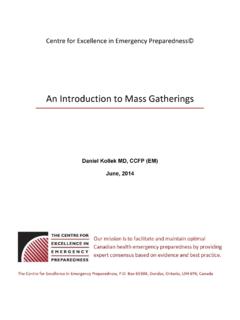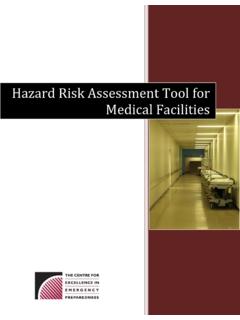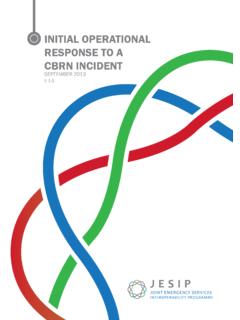Transcription of What is CBRN?
1 1 what is cbrn ? cbrn are weaponized or non-weaponized Chemical, Biological, Radiological and Nuclear materials that can cause great harm and pose significant threats in the hands of terrorists. Weaponized materials can be delivered using conventional bombs ( , pipe bombs), improved explosive materials ( , fuel oil-fertilizer mixture) and enhanced blast weapons ( , dirty bombs). Non-weaponized materials are traditionally referred to as Dangerous Goods (DG) or Hazardous Materials (HAZMAT) and can include contaminated food, livestock and crops. what is a cbrn incident An accidental cbrn incident is an event caused by human error or natural or technological reasons, such as spills, accidental releases or leakages.
2 These accidental incidents are usually referred to as DG or HAZMAT accidents. Outbreaks of infectious diseases, such as SARS, or pandemic influenza are examples of naturally occurring biological incidents. An intentional cbrn incident includes: criminal acts such as the deliberate dumping or release of hazardous materials to avoid regulatory requirements the malicious, but non-politically motivated poisoning of one or more individuals terrorist acts (as defined in the Criminal Code of Canada and the Security Offences Act) that involve serious violence to persons or property for a political, religious or ideological purpose and/or that are a matter of national interest The response to an intentional cbrn incident may be similar to an accidental cbrn incident.
3 However, intentional cbrn incidents differ because there are unique implications relating to federal/provincial/territorial responsibilities, public safety, public confidence, national security and international relations. cbrn incidents may include all or some of the following characteristics: potential for mass casualties potential for loss of life potential for long term effects creation of an extremely hazardous environment relative ease and cheapness of production initial ambiguity and/or delay in determining the type of material involved potential use of a combination of cbrn materials each presenting different response requirements narrow time frame in which to administer life saving interventions/treatments.
4 Need for immediate medical treatment for mass casualties need for immediately available specialised pharmaceuticals need for specialised detection equipment need for timely, efficient and effective mass decontamination systems 2 need for organised, trained and equipped health service personnel to immediately augment local Fire-HAZMAT teams need for pre-coordination within health services to establish medical treatment protocols, to stock pharmaceuticals and to determine treatment requirements need to establish coordinated incident management/response procedures for such incidents; need to ensure early warning systems for hospitals need to establish early those who are affected and those at risk need for active case finding versus passive case finding need to work closely with Police on site and at health care facilities, as they perform their legal duties in relation to victim identification/registration and evidence gathering need for a pro-active media policy to ensure the community is informed and thus its anxiety allayed.
5 Countermeasures include: Technical equipment such as respirators that can detect chemical agents and masks that prevent exposure Medical therapy and, for some agents, prophylaxis Organizational strategies, such as specially developed intelligence systems, standard operating procedures, and training Instruments of international law. what are biological weapons? Biological weapons are weapons that achieve their intended effects by infecting people with disease-causing microorganisms and other replicative entities, including viruses, infectious nucleic acids and prions. The chief characteristic of biological agents is their ability to multiply in a host over time.
6 The disease they may cause is the result of the interaction between the biological agent, the host (including the host s genetic constitution, nutritional status and the immunological status of the host s population) and the environment ( , sanitation, temperature, water quality, population density). Biological agents are commonly classified according to their taxonomy ( , fungi, bacteria, viruses). This classification is important because of its implications for detection, identification, prophylaxis and treatment. Biological agents can also be characterized by other features, such as infectivity, virulence, lethality, pathogenicity, incubation period, contagiousness and mechanisms of transmission, and stability -- all of which affect their potential to be used as weapons.
7 The following definition of these terms are based on those of J M Last, A dictionary of epidemiology, fourth edition, Oxford University Press, 2001. The infectivity of an agent is its capability to enter, survive and multiply in a host, and may be expressed as the proportion of persons exposed to a given dose who become infected. Virulence is the relative severity of the disease caused by a microorganism ( , the ratio of clinical cases to the number of infected hosts). Different strains of the same microorganism may cause diseases of different severity. For example, infection due to Brucella melitensis is usually more severe than infection due to B.
8 Suis or to B. abortus. Lethality is the ability of an agent to cause death in an infected population. The case-fatality rate ( , the proportion of patients clinically recognized as having a specified disease who die as a result of that illness within a specified time) provides useful information on the clinical management of cases. Pathogenicity is the capacity of a microorganism to cause disease, and is measured by the ratio of the number of clinical cases to the number of exposed persons. 3 The incubation period is the time between exposure to an infective agent and the first appearance of the signs and symptoms of disease. The incubation period can be affected by many variables, such as the initial dose, virulence, route of entry, rate of replication, and the immunological status of the host.
9 For those infections that are contagious, a measure of their contagiousness is the number of secondary cases following exposure to a primary case in relation to the total number of exposed susceptible secondary contacts. The mechanisms of transmission involved may be direct ( , direct contact between an infected and an uninfected person) or indirect. ( , through inanimate material that has become contaminated with the agent, such as soil, blood, bedding, clothes, surgical instruments, water, food or milk). Infections may also be through airborne droplets ( , through coughing or sneezing) or through vectors, such as biting insects. The distinction between types of transmission is important in selecting control measures.
10 For example, direct transmission can be interrupted by appropriate handling of infected persons, while interrupting indirect transmission requires other approaches, such as adequate ventilation, chlorination of water, or vector control. Stability is the ability of the agent to survive the influence of environmental factors such as air pollution, sunlight and extreme temperatures or humidity. what are chemical weapons? Chemical weapons are those that are effective because of their toxicity: that is, their chemical action can cause death, permanent harm or temporary incapacity. Weapons that use chemicals as propellants, explosives, incendiaries or obscurants are not chemical weapons, even though the chemicals in them may also have toxic effects.
